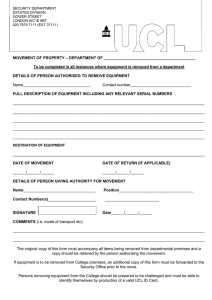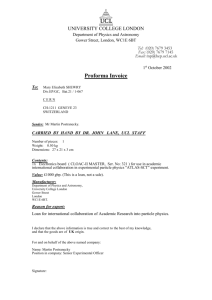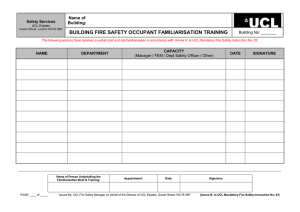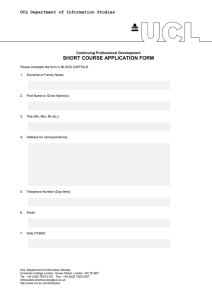EMERGENCY PLAN CAMPBELL HOUSE (WEST) UNIVERSITY COLLEGE LONDON
advertisement
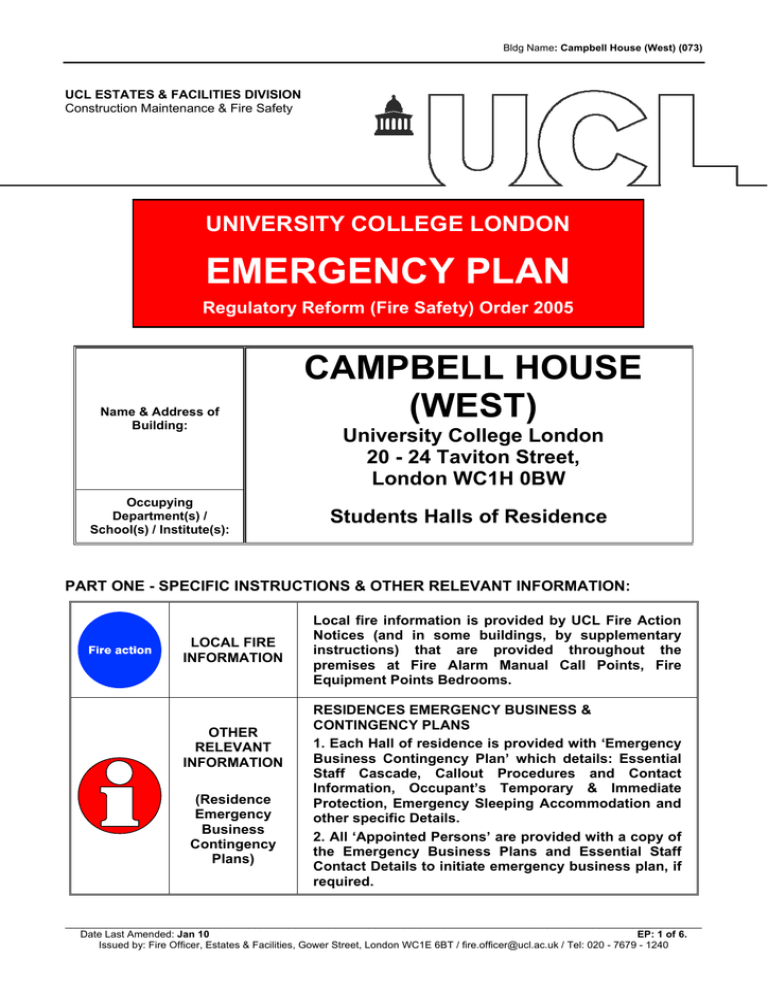
Bldg Name: Campbell House (West) (073) UCL ESTATES & FACILITIES DIVISION Construction Maintenance & Fire Safety UNIVERSITY COLLEGE LONDON EMERGENCY PLAN Regulatory Reform (Fire Safety) Order 2005 Name & Address of Building: Occupying Department(s) / School(s) / Institute(s): CAMPBELL HOUSE (WEST) University College London 20 - 24 Taviton Street, London WC1H 0BW Students Halls of Residence PART ONE - SPECIFIC INSTRUCTIONS & OTHER RELEVANT INFORMATION: LOCAL FIRE INFORMATION OTHER RELEVANT INFORMATION (Residence Emergency Business Contingency Plans) Local fire information is provided by UCL Fire Action Notices (and in some buildings, by supplementary instructions) that are provided throughout the premises at Fire Alarm Manual Call Points, Fire Equipment Points Bedrooms. RESIDENCES EMERGENCY BUSINESS & CONTINGENCY PLANS 1. Each Hall of residence is provided with ‘Emergency Business Contingency Plan’ which details: Essential Staff Cascade, Callout Procedures and Contact Information, Occupant’s Temporary & Immediate Protection, Emergency Sleeping Accommodation and other specific Details. 2. All ‘Appointed Persons’ are provided with a copy of the Emergency Business Plans and Essential Staff Contact Details to initiate emergency business plan, if required. _______________________________________________________________________________________________________________ Date Last Amended: Jan 10 EP: 1 of 6. Issued by: Fire Officer, Estates & Facilities, Gower Street, London WC1E 6BT / fire.officer@ucl.ac.uk / Tel: 020 - 7679 - 1240 Bldg Name: Campbell House (West) (073) PART TWO - SITE OR BUILDING SPECIFIC EVACUATION INSTRUCTIONS: ITEMS SPECIFIC INFORMATION OF INSTRUCTION 1. ESCAPE FROM UPPER FLOORS: (a.) General - Via single protected stairs (Stair A, B, C, D & E) and at the ground floor protected route to discharging at the main entrance on to street. Fire Escape (b). House 23 & 24 (1st & 2nd Floors) - have alternative escape at 1st & 2nd floor levels with access via link corridors between Stairs D & E. 2. ESCAPE FROM GROUND & LOWER GROUND LEVELS TO A PLACE OF SAFETY. (a.) Ground Floor - Fire Exit is via the relevant Main Entrance onto 20 - 24 Taviton Street. Fire Escape (b.) Lower Ground Level - Either via Stairs A, B C, D & E up to Ground Floor Entrance Lobby and out to Taviton Street. Alternatively, a protected internal route is provided to the rear fire exit and around rear of build to south side of Campbell House and then to Stair K and up to Taviton Street. 3. FIRE ASSEMBLY POINT The Fire Assembly Point is located on Taviton Street: Assembly Point Mandatory! Hotel Operations • Extreme Care is required by all occupants in respect road traffic passing along the road. • On Evacuation, occupants are requested to keep noise to a minimum (particularly during nighttimes). 4. OPERATING AS A HOTEL (a). Additional trained staff (including Security & Reception Staff) may be required to be on duty to supplement the ‘Appointed Persons’ role when operating in Hotel mode. (b). It is recommended that ‘staff’ employed when operating as a Hotel are trained at regular interval (suggested 3 monthly for Night Staff & 6 monthly for Day Staff) as Fire Evacuation Marshals (FEMS) and have local familiarisation training including details of the Emergency Plan & recorded on the UCL Fire Safety Technical Note (TN) 086 - Training Record. (c). Regulatory Reform (Fire Safety) Order 2005 – Fire Safety Guide Sleeping Accommodation (Issued by HM Government) Section 7 provides further guidance staff training and procedures. _______________________________________________________________________________________________________________ Date Last Amended: Jan 10 EP: 2 of 6. Issued by: Fire Officer, Estates & Facilities, Gower Street, London WC1E 6BT / fire.officer@ucl.ac.uk / Tel: 020 - 7679 - 1240 Bldg Name: Campbell House (West) (073) PART THREE - DISABILITY PROVISIONS RELATING TO EMERGENCY DISABLED EVACUATION (CONT): ITEMS DISABLED PROVISION WITHIN THE BUILDING DISABLED SIGNAGE: Fire safety and directional signage provided within the premises: NO * Remarks: No Disabled Facilities need at present DISABLED EVACUATION LIFTS: Complying with BS 5588 Part 8 are provided in this building: NO * Remarks: No Disabled Facilities need at present DEAF PEOPLE FIRE ALARM ALERTING FACILITIES: Vibrating Pager equipment has been provided and is connected to the fire alarm system: NO * Remarks: No Disabled Facilities need at present VISUAL SIGNALS - equipment, tactile signage, colour coding or other faculties have been provided as part of the fire evacuation strategy for this building: NO * Remarks: No Disabled Facilities need at present DISABLED REFUGE COMMUNICATIONS FACILITIES: Communication facilities for Disabled Refuges / Safe Havens have Telephone (BT Big Button / Communications system complying BS 5839 Part 9) in the premises: NO * Remarks: No Disabled Facilities need at present DISABLED REFUGE FACILITIES: Generally, only provided on individual Risk Assessment or as part of a PEEP initiated by the Department NO * Remarks: No Disabled Facilities need at present Location: Where refuges are provided, they should be enclosed in a fireresisting structure, which creates a protected escape route leading directly to a place of safety and should only be used in conjunction with effective management rescue arrangements. None _______________________________________________________________________________________________________________ Date Last Amended: Jan 10 EP: 3 of 6. Issued by: Fire Officer, Estates & Facilities, Gower Street, London WC1E 6BT / fire.officer@ucl.ac.uk / Tel: 020 - 7679 - 1240 Bldg Name: Campbell House (West) (073) PART FOUR - BACKGROUND INFORMATION & ARRANGEMENTS: LOCAL FIRE INFORMATION Local fire information is provided by UCL Fire Action Notices (and in some premises, by supplementary instructions) which are provided throughout the premises at Fire Alarm Manual Call Points, Fire Equipment Points and in sleeping accommodation rooms, as appropriate. ACTION ON DISCOVERING A FIRE On discovery or being made aware of a fire, immediately raise the alarm throughout the building by operating the nearest fire alarm call point, or as per the premises fire action notices. CALLING THE FIRE BRIGADE Dial (9)999/112 (or Ext: 222 on a UCL internal Extension in some Halls or Residences) and report the fire (if you are unsure of your location use the Building Reference number to assist in identifying the premises, which is shown on the UCL Fire Action Notices). This building’s fire alarm system is monitored on a 24-hour basis by either the UCL Security Control Room or a Call Receiving Centre who will summon the Fire Brigade. However, you should always make an Emergency Telephone call (999 / 222) to raise the alarm. ON HEARING THE FIRE ALARM On hearing the fire alarm, immediately leave the building by the nearest available fire exit (this may not necessarily be the way you entered the building). THE FIRE ALARM SYSTEM (1). This building is equipped with a single stage addressable fire alarm system. Which when activated, emits a continuous electronic two-tone alarm throughout the building. (2). Automatic Fire Detection (AFD) – smoke & heat detecting devices are provided for early warning to Life 2 (L2) Standard. (3). Fire alarm ‘Manual Call Points’ are found on routes leading from the building (including corridors, landings, staircases & final exits). EVACUATION PROCEDURE On hearing the alarm or being directed by a Fire Evacuation Marshal (FEM), Staff or a Warden, all occupants are to evacuate the building by the nearest available escape stair, corridor or exit route to the Final Exit. If your escape route is blocked or obstructed by fire or smoke, you should turn your back on the fire and follow the alternative route from the building by following the green safe condition fire safety direction signage provided. FIRE ASSEMBLY POINT On leaving the building you should proceed to the Fire Assembly Point; the location of the Fire Assembly Point(s) is indicated on the local Fire Action Notices provided, which may also be supplemented with additional information such as local escape route plans etc. Do not obstruct the building entrances as this may hinder access to the fire brigade crews & appliances. Beware of the road traffic and your and others safety during the evacuation! ELECTRONIC SECURITY DOOR RELEASE MECHANISMS Where fitted doors forming part of the Means of Escape (MoE) may be provided with Electromagnetic Security Locks (Cardex): (1). Will release on Activation of the Fire Alarm System, (but there are some exceptions to this arrangement). (2). Each door is provided with an independent ‘break glass’ emergency release device (green box) on the direction of escape that should be broken to release the door in an emergency (or if the fire alarm has not activate). _______________________________________________________________________________________________________________ Date Last Amended: Jan 10 EP: 4 of 6. Issued by: Fire Officer, Estates & Facilities, Gower Street, London WC1E 6BT / fire.officer@ucl.ac.uk / Tel: 020 - 7679 - 1240 Bldg Name: Campbell House (West) (073) Part Four - Background Information & Arrangements (Continued): PLAN OF THE EMERGENCY ROUTES Fire safety drawings are provided with the Emergency Plan for the building. These plans show the fire escape stairs, routes emergency door furniture and final exits with copies available to the Fire Brigade at the main entrance of the building (or through the UCL Fire Officer). EMERGENCY & ESCAPE LIGHTING Emergency escape lighting is provided in large &/or specific rooms, all corridors and stair enclosures to illuminate safely the escape routes from the premises in the event of a ‘Local Lighting Circuit’ failure (they do not illuminate on the fire alarm sounding). In addition, illuminated directional escape signage may also be provided. FIRE FIGHTING EQUIPMENT Fire fighting equipment is strategically placed throughout the building in accordance with the hazards identified. Only use fire-fighting equipment if it is safe for you to do so; and you are confident that you are using the most appropriate fire extinguisher on the correct type fire. Do not use water on electrical or flammable liquid fires! Provision of ‘Appointed Persons’ – The Dean of Students has designated as ‘Appointed Persons’ all Wardens, Vice Wardens, Residential and Managerial Staff for each Hall of Residence. The principal duties of an ‘Appointed Person’ are: Out of Normal Working Hours APPOINTED PERSONS (a). Raising the local fire alarm where necessary and ensuring that the Emergency Services are called by dialling ‘999’/ ‘Ext 222’ on a suitable landline or mobile telephone; (b). Marshalling students (& guests) to the appropriate Fire Assembly Point; (c). Liaising with the local Authority Senior Fire Officer in attendance in respect of details: of the location of the fire or incident, any trapped or injured occupants (if known); providing Keys / Codes for access; local information and general assistance as necessary, to deal with the incident. HAZARDOUS SUBSTANCES SECURITY CONTROL ROOM (Emergencies) Hazardous substances are not used in significant quantities on the premises; or where they are used, it is generally in very small quantities in individually marked rooms or locations. UCL Security Control Room is staff on a 24/7 basis: Tel: Tel: Tel: 020 - 7679 - 3333 (Main Number) 020 - 7387 - 6342 (Alterative Number) 020 - 7679 - 2108 (UCL Security Front Lodge, Gower Street) _______________________________________________________________________________________________________________ Date Last Amended: Jan 10 EP: 5 of 6. Issued by: Fire Officer, Estates & Facilities, Gower Street, London WC1E 6BT / fire.officer@ucl.ac.uk / Tel: 020 - 7679 - 1240 Bldg Name: Campbell House (West) (073) Part Four - Background Information & Arrangements (Continued): MEETING THE FIRE BRIGADE & HAZARD INFORMATION Normal Working Hours - the fire brigade will be met by the Hall Manger / Appointed Person / FEMs. Out of Hours – the ‘Appointed Person’ will meet and assist the Fire Brigade and others, as required. Fire Brigade Contingency Plans & Hazard Information – Fire brigade contingency plans & hazard information is provided in a Red A4 Folder placed in the FB Premises Box provided close to the master fire alarm panel. EMERGENCY STOP OF COOKING EQUIPMENT KITCHENS Students using Kitchens should ensure that when the fire alarm has activated that all cooking facilities are shut down safely and quickly before leaving the area. If this is not possible, a responsible person must inform the Appointed Person or a Fire Brigade Officer of Cooking if left unattended on leaving the building. Cooking should NEVER be left unattended! INDUCTION FAMILIARISATION (Visitors & Contractors) The Director of Residences must have arrangements in place so that all temporary and permanent staff (including Maintenance / Cleaning / Catering Contractors) working for more than 3 days at a Residence, receive Local Fire Safety Induction familiarisation and an approved record kept of the familiarisation. TRAINING (Staff) The Director of Residences must have arrangements in place undertake local fire safety familiarisation of the building(s) where Residence Staff (including Maintenance / Cleaning / Catering Contractors) work or visit regularly Annually, and an approved record kept. Additionally, where there is a change of work activities or working environment for Staff Contractors or visitors they also receive a separate Familiarisation Briefing and a new record raised and kept. TRAINING (Students) The Dean of Students shall provide at the start of each academic session, as ‘good practice’ fire safety information to students and visitors. It is recommended that this information includes 'action in the event of fire and emergency evacuation procedures’ relevant to the student accommodation. This will generally take the form of the Fire Action Notices displayed in each residential bedrooms and any addition relevant information. STAFF & STUDENT TRAINING FIRE EVACUATION DRILLS The Dean of Students / Director of Residences shall carry out at the start of the Autumn Term (October) and at each academic session and adequate number of fire drills (preferably at least 1 per day and 1 during darkness). A record of each fire drill should be kept. Note: Unwanted alarm activations are treated as supplementary fire drills throughout the year. INDUCTION FAMILIARISATION (Visitors & Contractors) The Director of Residences must have arrangements in place so that all temporary and permanent staff (including Maintenance / Cleaning / Catering Contractors) working for more than 3 days at a Residence, receive Local Fire Safety Induction familiarisation and an approved record kept of the familiarisation. _______________________________________________________________________________________________________________ Date Last Amended: Jan 10 EP: 6 of 6. Issued by: Fire Officer, Estates & Facilities, Gower Street, London WC1E 6BT / fire.officer@ucl.ac.uk / Tel: 020 - 7679 - 1240
